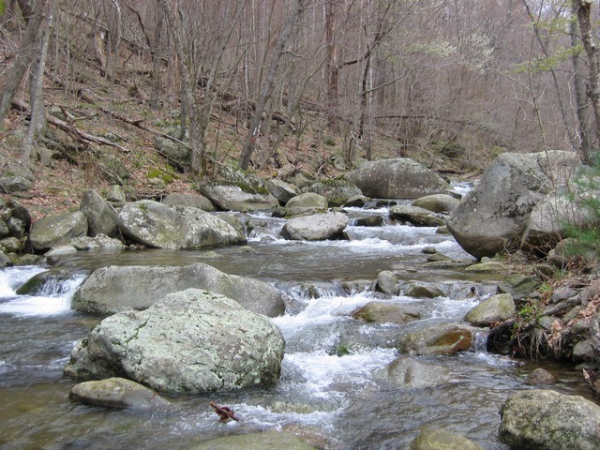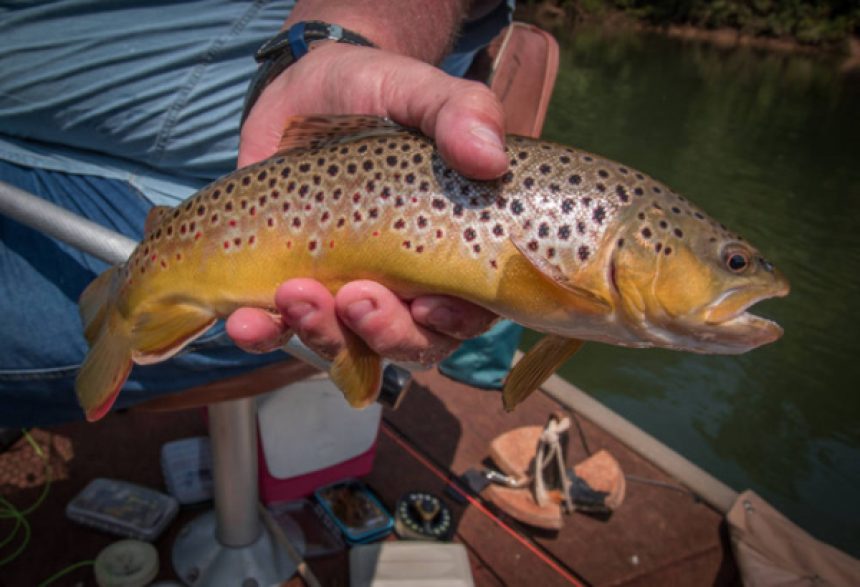By Craig Springer, USFWS
About the time tulip poplars, oaks, maples, and hickories are burnished the color of an ending season, brown trout and brook trout from Georgia to Maine turn their attention to a new beginning: procreation. The colorful flanks of these trout mirror the spectra of leaves that carpet the floor of the Appalachian Mountains. Brown trout sport a warm honey beneath black peppercorn spots all covered in a chrome sheen. Worm-like markings lay over the dark olive backs of brook trout, flanked with shades of yellow specks punctuated by drops of ox blood, each fish dotted in its own constellation.
Brook trout are native to streams that vein over Appalachia; brown trout are a European import, well established for decades. With shortening shadows and cooler temperatures, both species lay their eggs in gravelly redds where oxygen-rich water bathes through them the winter-long as they incubate. Brown trout may have a competitive edge over the native brook trout, particularly at lower elevations where warmer water favors brown trout. Other interactions between the two species are not well understood.

To learn more about how brook trout fare over a long span of time in the presence of brown trout, biologists John Odenkirk and Mike Isel with the Virginia Department of Wildlife Resources (VDWR) examined a large amount of data—nearly 25 years’ worth of information—on brook and brown trout in the Rapidan and Conway rivers of northern Virginia. Sport Fish Restoration dollars—federal excise taxes paid by fishing tackle manufacturers—funded their work. Odenkirk and Isel published their findings in the scientific Journal of the Southeastern Association of Fish and Wildlife Agencies, March 2022 issue.
The two streams offered a natural laboratory for easy comparison of fish data over the large span of time. Both streams flow through the Rapidan Wildlife Management Area, managed by the VDWR via Pittman-Robertson funds—excise taxes paid by archery, ammunition, and firearms manufacturers. The Rapidan harbors brook trout while both species occur in the Conway River. Brown trout were introduced in the Conway River in the 1970s, and have advanced throughout much of the stream.
The two scientists examined brook and brown trout data collected by the VDWR dating to the 1970s. They looked at total trout weight by water surface area over time, as well as a measure of fitness called relative weight in brook trout in the Conway River that might be negatively influenced by brown trout.

The scientists found no discernable trends in brook trout total trout weight by water surface area over time in either river. The relative weight of Conway River brook trout decreased only slightly over time. In essence, the brown trout seemed to have no bearing on the well-being of brook trout after co-occurring in the Conway River for 30 years. The scientists offer that the heathy, intact, forested Rapidan Wildlife Management Area that cover the watersheds of both rivers may favor brook trout. They suggest that state natural resources agencies should examine closely the need to eradicate brown trout from brook trout streams before embarking on such a costly endeavor. Moreover, Odenkirk and Isel conclude that in situations such as the Conway River, fishery managers might consider the potential brown trout possess for additional angling opportunities. This work is yet another example of how state fish and wildlife agencies use manufacturer excise taxes on fishing tackle to maximize angling opportunities.


